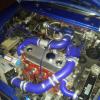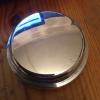
Removing Alternator For Racing
#16

Posted 14 April 2011 - 09:20 AM
#17

Posted 14 April 2011 - 09:28 AM
#18

Posted 14 April 2011 - 09:45 AM
I guess depending on the type of alternator you could switch off the signal wire which tells it when to charge- but do not just break the main charge wire!!!
#19

Posted 14 April 2011 - 11:56 AM
I guess depending on the type of alternator you could switch off the signal wire which tells it when to charge- but do not just break the main charge wire!!!
If you are suggesting disabling the field wiring on the alternator BEFORE starting the engine, that may or may not work. Some alternators will still produce a voltage spike when revved high enough that they will "self energize" and start producing power even with the field wiring connection disconnected. There doesn't seem to be rhyme or reason to this, it varies from alternator to alternator.
With the FIA certified cut-off switches, you break the power line OUT of the alternator AND you provide an earth connection for the alternator output through a discharge resistor. This allows you to switch off a running engine without killing the alternator.
#20

Posted 14 April 2011 - 01:14 PM
This allows you to switch off a running engine without killing the alternator.
Hi Doug, can you explain what you mean and why please ?
Thanks
Regards Martin
#21

Posted 14 April 2011 - 01:21 PM
#22

Posted 14 April 2011 - 08:57 PM
so what a bloke i know does is he has a switch in the alternator wiring so when he's in the pits/on the start line he has it charging, then just before he sets off flick the switch and alternator stops charging and the power increases
hope this helps rob
#23

Posted 14 April 2011 - 09:20 PM
Hi Doug, can you explain what you mean and why please ?This allows you to switch off a running engine without killing the alternator.
The issue is that if the alternator is pumping current to the battery, the battery is acting as a load and the regulator circuit of the alternator expects that load to be there. If you suddenly break the connection between the alternator and the battery, the load disappears and the regulator may not be able to shut the output down quickly enough. The result is a voltage spike that has been known to damage the regulator circuit. The resistor C4NNON and I mentioned acts as a power dissipating load when the FIA kill switch is actuated. When the switch is turned "off", the alternator output is separated from the battery and at the same moment it is directed to earth through the resistor.
Valve Bounce, if your friend is just throwing a switch to separate the alternator output from the battery, he/she is very lucky they have not damaged the regulator circuit. Our Formula-Vee operates without an alternator. We fully charge the battery between sessions and jump start the car off the tow vehicle battery. Using the tow vehicle to start the car's engine prevents us from pulling the battery down low and leaves plenty of power in the battery for the race.
#24

Posted 14 April 2011 - 09:26 PM
The FIA switches have an extra 4 terminals on the back, one of which goes to earth through a big resistor- when you turn the switch off it also connects the earthed terminal and dumps and current in the system to earth harmlessly- although actually I'm not sure if that is more for ignition than alternator...
thats to do with the alternator, as if you just cut the switch if it was only wired into one of the battery cables, the alternator would keep the engine running. i think if i remember correctly, the wire/s carrying the charge from the alternator have to pass through this switch before going anywhere else.
none of the race cars at work (spridgets) run alternators or waterpumps. they use electric waterpumps and varley batteries, a battery easily does 4 half hour sessions. thats powering an air/fuel gauge, electric waterpump, electric fan sometimes, electric fuel pump, lap timer and transponder.
Edited by samsfern, 14 April 2011 - 09:28 PM.
#25

Posted 14 April 2011 - 09:44 PM
However, the output of an alternator is governed by, amongst other things, the magnetism in the rotor which is largely controlled by the current in the field winding. If you disconnect the output then the controller will reduce the field current to a minimum in an attempt to limit the output voltage (ie pressure). Whether the field current gets turned off completely I do not know, but any small field current and residual magnetism in the rotor may well cause the alternator to overvolt and kill the rectifiers. Alternatively, the overvolting might kill the field current control circuit which itself could cause a fryup. I can understand the need to keep some load on an alternator.
#26

Posted 15 April 2011 - 12:41 PM
The important issue for alternator life is as you describe in your second paragraph. During disconnect, a voltage spike is possible which will damage the diodes in the alternator. This is the same reason why you should not unplug the alternator on a running engine to perform charging system troubleshooting. It was common practice when dynamos were common but it is not a good practice with alternators.
Product description mentioning kill switch to NOT feed back into ignition system.
http://www.pegasusau....asp?RecID=4913
Wiring description regarding protecting diodes with field disconnect
http://bluesea.com/viewresource/91
Typical FIA switch wiring (with schematic)
http://www.sideways-...l?m-1203554446/
Note in the schematic that one of the low-power FIA switch contacts is used to break current flowing through the coil.
The other contact closes when the disconnect is actuated so that the alternator output is directed to earth through the 3 Ohm resistor.
#27

Posted 15 April 2011 - 01:10 PM
Back to the original topic - surely a kill switch's resistor is just an alternative load and the alternator will still consume HP to heat it? I suppose it depends on how it compares to running ignition & charging a battery.
#28

Posted 15 April 2011 - 03:32 PM
1) The original poster's question about running an engine without an alternator and
2) The function of FIA the kill switches (and what they do regarding alternator output).
With the FIA kill switches you are simultaneously breaking the power supply to the ignition coil, separating the alternator's output from the battery and connecting the alternator output to earth.
Under those circumstances the alternator will only produce output as long as it continues to spin (coasting in-gear in this case) so you don't need a huge resistor as the engine is incapable of continuing to run.
In the context of the original poster's question, if you were to disconnect the output of the alternator from the battery with the engine running you risk damaging the diodes in the alternator. However, you could disconnect the alternator PRIOR to starting the engine so the engine is running only on the battery. Under that scenario you would save a bit of power that would normally be used to recharge the battery. If the battery is nearly fully charged the math indicates that the power savings are minimal.
#29

Posted 15 April 2011 - 08:48 PM
1 user(s) are reading this topic
0 members, 1 guests, 0 anonymous users



















